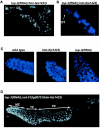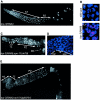Multiple genetic pathways involving the Caenorhabditis elegans Bloom's syndrome genes him-6, rad-51, and top-3 are needed to maintain genome stability in the germ line
- PMID: 15143192
- PMCID: PMC416432
- DOI: 10.1128/MCB.24.11.5016-5027.2004
Multiple genetic pathways involving the Caenorhabditis elegans Bloom's syndrome genes him-6, rad-51, and top-3 are needed to maintain genome stability in the germ line
Abstract
Bloom's syndrome (BS) is an autosomal-recessive human disorder caused by mutations in the BS RecQ helicase and is associated with loss of genomic integrity and an increased incidence of cancer. We analyzed the mitotic and the meiotic roles of Caenorhabditis elegans him-6, which we show to encode the ortholog of the human BS gene. Mutations in him-6 result in an enhanced irradiation sensitivity, a partially defective S-phase checkpoint, and in reduced levels of DNA-damage induced apoptosis. Furthermore, him-6 mutants exhibit a decreased frequency of meiotic recombination that is probably due to a defect in the progression of crossover recombination. In mitotically proliferating germ cells, our genetic interaction studies, as well as the assessment of the number of double-strand breaks via RAD-51 foci, reveal a complex regulatory network that is different from the situation in yeast. Although the number of double-strand breaks in him-6 and top-3 single mutants is elevated, the combined depletion of him-6 and top-3 leads to mitotic catastrophe concomitant with a massive increase in the level of double-strand breaks, a phenotype that is completely suppressed by rad-51. him-6 and top-3 are thus needed to maintain low levels of double-strand breaks in normally proliferating germ cells, and both act in partial redundant pathways downstream of rad-51 to prevent mitotic catastrophy. Finally, we show that topoisomerase IIIalpha acts independently during a late stage of meiotic recombination.
Figures






Similar articles
-
Coaction of DNA topoisomerase IIIalpha and a RecQ homologue during the germ-line mitosis in Caenorhabditis elegans.Genes Cells. 2002 Jan;7(1):19-27. doi: 10.1046/j.1356-9597.2001.00496.x. Genes Cells. 2002. PMID: 11856370
-
Endogenous gamma-H2AX-ATM-Chk2 checkpoint activation in Bloom's syndrome helicase deficient cells is related to DNA replication arrested forks.Mol Cancer Res. 2007 Jul;5(7):713-24. doi: 10.1158/1541-7786.MCR-07-0028. Mol Cancer Res. 2007. PMID: 17634426
-
Expression and nuclear localization of BLM, a chromosome stability protein mutated in Bloom's syndrome, suggest a role in recombination during meiotic prophase.J Cell Sci. 2000 Feb;113 ( Pt 4):663-72. doi: 10.1242/jcs.113.4.663. J Cell Sci. 2000. PMID: 10652259
-
Bloom syndrome helicase in meiosis: Pro-crossover functions of an anti-crossover protein.Bioessays. 2017 Sep;39(9):10.1002/bies.201700073. doi: 10.1002/bies.201700073. Epub 2017 Aug 9. Bioessays. 2017. PMID: 28792069 Free PMC article. Review.
-
DNA repair.WormBook. 2006 Jan 13:1-12. doi: 10.1895/wormbook.1.54.1. WormBook. 2006. PMID: 18050489 Free PMC article. Review.
Cited by
-
Bloom's Syndrome: Clinical Spectrum, Molecular Pathogenesis, and Cancer Predisposition.Mol Syndromol. 2017 Jan;8(1):4-23. doi: 10.1159/000452082. Epub 2016 Nov 5. Mol Syndromol. 2017. PMID: 28232778 Free PMC article. Review.
-
DNA double-strand break repair in Caenorhabditis elegans.Chromosoma. 2011 Feb;120(1):1-21. doi: 10.1007/s00412-010-0296-3. Epub 2010 Nov 5. Chromosoma. 2011. PMID: 21052706 Free PMC article. Review.
-
WRN helicase regulates the ATR-CHK1-induced S-phase checkpoint pathway in response to topoisomerase-I-DNA covalent complexes.J Cell Sci. 2011 Dec 1;124(Pt 23):3967-79. doi: 10.1242/jcs.081372. Epub 2011 Dec 8. J Cell Sci. 2011. PMID: 22159421 Free PMC article.
-
Molecular characteristics of reiterative DNA unwinding by the Caenorhabditis elegans RecQ helicase.Nucleic Acids Res. 2019 Oct 10;47(18):9708-9720. doi: 10.1093/nar/gkz708. Nucleic Acids Res. 2019. PMID: 31435650 Free PMC article.
-
DNA repair, recombination, and damage signaling.Genetics. 2022 Feb 4;220(2):iyab178. doi: 10.1093/genetics/iyab178. Genetics. 2022. PMID: 35137093 Free PMC article. Review.
References
-
- Ababou, M., V. Dumaire, Y. Lécluse, and M. Amor-Guéret. 2002. Bloom's syndrome protein response to ultraviolet-C radiation and hydroxyurea-mediated DNA synthesis inhibition. Oncogene 21:2079-2088. - PubMed
-
- Adams, M. D., M. McVey, and J. J. Sekelsky. 2003. Drosophila BLM in double-strand break repair by synthesis-dependent strand annealing. Science 299:265-267. - PubMed
-
- Ahmed, S., A. Alpi, M. O. Hengartner, and A. Gartner. 2001. Caenorhabditis elegans RAD-5/CLK-2 defines a new DNA damage checkpoint protein. Curr. Biol. 11:1934-1944. - PubMed
-
- Alpi, A., P. Pawel, A. Gartner, and J. Loidl. 2003. Genetic and cytological characterization of the recombination protein RAD-51 in Caenorhabditis elegans. Chromosoma 112:6-16. - PubMed
-
- Bishop, D. K., D. Park, L. Xu, and N. Kleckner. 1992. DMC1: a meiosis-specific yeast homolog of Escherichia coli recA required for recombination, synaptonemal complex formation, and cell cycle progression. Cell 69:439-456. - PubMed
Publication types
MeSH terms
Substances
LinkOut - more resources
Full Text Sources
Molecular Biology Databases
Research Materials
